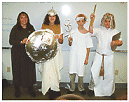|
● Going
to School in America Today
● Education—A Local Matter
● What
an American Student Learns
● Education
in a New Nation
● Learning
to Be World Citizens
● Higher Education
● Selecting
a College or University
● Trends in Degree Programs
● Education for All
What an American Student Learns
 |
|
Learning Computer
|
 American
students pass through several levels of schooling—and thus, several
curricula—on their way to a high school diploma. They attend: American
students pass through several levels of schooling—and thus, several
curricula—on their way to a high school diploma. They attend:
 Elementary
School. In statistical reports published by the federal government,
"elementary school" usually means grades kindergarten(K)
through 8. But in some places, the elementary school includes only
grades K—6. And sometimes grades 4, 5 and 6 make up what
is called a "middle grade" school.(Many Americans refer
to the elementary grades as "grammar school.") Elementary
School. In statistical reports published by the federal government,
"elementary school" usually means grades kindergarten(K)
through 8. But in some places, the elementary school includes only
grades K—6. And sometimes grades 4, 5 and 6 make up what
is called a "middle grade" school.(Many Americans refer
to the elementary grades as "grammar school.")
 Secondary
School. Again, in statistical
reports, "secondary school" generally means grades 9-12.
These grades are popularly called "high school." However,
in many districts, "junior high school" includes grades
7 * 9. And when grades 7 * 9 are included with the 10th, 11th and
12th grades, all six are said to form a "senior high school." Secondary
School. Again, in statistical
reports, "secondary school" generally means grades 9-12.
These grades are popularly called "high school." However,
in many districts, "junior high school" includes grades
7 * 9. And when grades 7 * 9 are included with the 10th, 11th and
12th grades, all six are said to form a "senior high school."
 Although
there is no national curriculum in the United States, certain subjects
are taught in all K to 12 systems across the country. Although
there is no national curriculum in the United States, certain subjects
are taught in all K to 12 systems across the country.
 Almost
every elementary school provides instruction in these subjects:
mathematics; language arts (subject that includes reading, grammar,
composition and literature); penmanship; science; social
studies (a subject that includes history, geography, citizenship
and economics); music; art; and Almost
every elementary school provides instruction in these subjects:
mathematics; language arts (subject that includes reading, grammar,
composition and literature); penmanship; science; social
studies (a subject that includes history, geography, citizenship
and economics); music; art; and
 |
|
Drama
|
physical education. In many elementary
schools, courses in the use of computers have been introduced. And
in some cases, a second language (other than English) is offered
in the upper elementary grades.
 Most
secondary schools offer the same "core" of required
subjects: English, mathematics, science, social studies and physical
education. But school boards differ greatly from one district to
another in the amount of class time they want high school students
to spend on these basic subjects. In some high schools, for example,
students must complete three years of mathematics before graduation.
The national average is lower. Most
secondary schools offer the same "core" of required
subjects: English, mathematics, science, social studies and physical
education. But school boards differ greatly from one district to
another in the amount of class time they want high school students
to spend on these basic subjects. In some high schools, for example,
students must complete three years of mathematics before graduation.
The national average is lower.
 Students
are guided by school counselors in choosing electives,
which can range from specialized academic to vocational subjects. Students
are guided by school counselors in choosing electives,
which can range from specialized academic to vocational subjects.
 For
example, high schools offer more than one year—in most cases, several
years—of math, science and the other core subjects. After they
complete the required units in these core areas (for example, one
year of American history), students can take additional units as
electives (perhaps a year of European history and a year of world
political issues). For
example, high schools offer more than one year—in most cases, several
years—of math, science and the other core subjects. After they
complete the required units in these core areas (for example, one
year of American history), students can take additional units as
electives (perhaps a year of European history and a year of world
political issues).
 Other
elective courses vary from school to school. Some high schools specialize
in particular types of subjects—business education, or industrial
trades, or foreign languages, for example. A student planning to
be a physician would want to attend a school offering many electives
in science. Other
elective courses vary from school to school. Some high schools specialize
in particular types of subjects—business education, or industrial
trades, or foreign languages, for example. A student planning to
be a physician would want to attend a school offering many electives
in science.
Previous Page Next
Page
|

